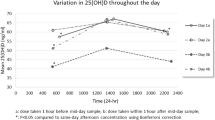Abstract
This study was aimed at assessing the circadian rhythm of serum iron levels in Chinese healthy subjects. The project was conducted in 19 healthy, Chinese male subjects following a 4-day diet equilibration. Blood samples were collected on day 5 at 0800, 1000, 1200, 1400, 1600, 1800, 2000, and 2400 hours to determine endogenous serum iron concentrations. Iron concentrations were determined using an inductively coupled plasma mass spectrometry. Iron concentration was decreased from morning to afternoon. The minimum value of iron level was 1,987 μg/L at 2000 hours while the maximum was 2,229 μg/L at 1000 hours, and 2,278 μg/L at 1400 hours, respectively, the amplitude was 291 μg/L. This study indicates that when assessing the bioequivalence of iron formulations, baseline levels of iron (obtained before dosing) should not be subtracted simply from the amount obtained on the drug dosing day to yield the net effect of iron formulation administration. More valid methods to optimize the design of such bioequivalence studies should be taken into consideration.

Similar content being viewed by others
References
Drew P, Charles RJS (2006) Oxford handbook of clinical hematology, 2nd edn. People’s Military Medical Press, Beijing, pp 40–42
Wiltink WF, Kruithof J, Mol C et al (1973) Diurnal and nocturnal variations of the serum iron in normal subjects. Clin Chim Acta 49:99–104
Statland BE, Winkel P, Bokelund H (1976) Variation of serum iron concentration in young healthy men: within-day and day-to-day changes. Clin Biochem 9:26–29
Hamilton LD, Gubler CJ, Cartwright GE (1950) Diurnal variation in the plasma iron level of man. Proc Soc Exp Biol Med 75:65–68
Costongs GM, Janson PC, Bas BM et al (1985) Short-term and long-term intra-individual variations and critical differences of clinical chemical laboratory parameters. J Clin Chem Clin Biochem 23:7–16
European Agency for the Evaluation of Medicinal Products (EMEA). International Conference on Harmonisation—World Health Organization. Guideline for good clinical practice. ICH E6 http://www.ich.org/products/guidelines.html. Accessed 26 January 2009
Long R, Delaney KK, Siegel L (1978) Diurnal variation of serum iron in normal individuals. Clin Chem 24:842–844
Malhotra S, Garg SK, Khullar GK et al (2004) Kinetics of two different iron formulations and their effect on diurnal variation of serum iron levels. Methods Find Exp Clin Pharmacol 26:417–420
Liu JQ (2005) Effect of ferrous succinate on iron deficiency anemia. Med J West China 17:24–25
De Souza AL, Batista FM, Ferreira LO et al (2004) The effectiveness of three regimens using ferrous sulfate to treat anemia in pregnant women. Rev Panam Salud Publica 15:313–319
Hadler MC, Sigulem DM, Alves Mde F et al (2008) Treatment and prevention of anemia with ferrous sulfate plus folic acid in children attending daycare centers in Goiania, Goias State, Brazil: a randomized controlled trial. Cad Saude Publica 24:S259–S271
Xiong Y, Zou DD, Song GY (2004) Effect of ferrous succinate on children iron deficiency anemia. Chongqing Med 33:913–915
Schindel F (2000) Consideration of endogenous backgrounds in pharmacokinetic analyses: a simulation study. Eur J Clin Pharmacol 56:685–688
Lugan I, Febbraro S, Lecuelle H et al (2005) Bioequivalence of liquid and bioequivalence of freeze-dried recombinant human follicle-stimulating hormone. Curr Med Res Opin 211:21–125
Jacobsen LV, Rolan P, Christensen MS et al (2000) Bioequivalence between ready-to-use recombinant human rowth hormone (rhGH) in liquid formulation and rhGH for reconstitution. Growth Horm IGF Res 10:93–98
Voortman G, Van de PJ, Schoemaker RC (1999) Bioequivalence of subcutaneous injections of recombinant human follicle stimulating hormone (Puregon(R)) by Pen-injector and syringe. Hum Reprod 14:1698–1702
US Dept of Health and Human Services, Food and Drug Administration Center for Drug Evaluation and Research (2005) Guidance for industry: potassium chloride modified-release tablets and capsules: in vivo bioequivalence and in vitro dissolution testing. http://www.fda.gov/cder/guidance/index.htm. Accessed 7 May 2009
Walter SI, Clanget C, Ding R et al (2004) Assessment of levothyroxine sodium bioavailability: recommendations for an improved methodology based on the pooled analysis of eight identically designed trials with 396 drug exposures. Clin Pharmacokinet 43:1037–1053
Zimmermann H, Koytchev R, Mayer O et al (1998) Pharmacokinetics of orally administered estradiol valerate. Results of a single-dose cross-over bioequivalence study in postmenopausal women. Arzneimittelfor-schung 48:941–947
US Dept of Health and Human Services, Food and Drug Administration Center for Drug Evaluation and Research (2000) Guidance for industry: levothyroxine sodium tablets-in vivo pharmacokinetic and bioavailability studies and in vitro dissolution testing. http://www.fda.gov/cder/guidance/index.htm Accessed 10 March 2005
Author information
Authors and Affiliations
Corresponding author
Rights and permissions
About this article
Cite this article
Cao, G.Y., Li, Y., Jin, P.F. et al. Circadian Rhythm in Serum Iron Levels. Biol Trace Elem Res 147, 63–66 (2012). https://doi.org/10.1007/s12011-011-9304-6
Received:
Accepted:
Published:
Issue Date:
DOI: https://doi.org/10.1007/s12011-011-9304-6




